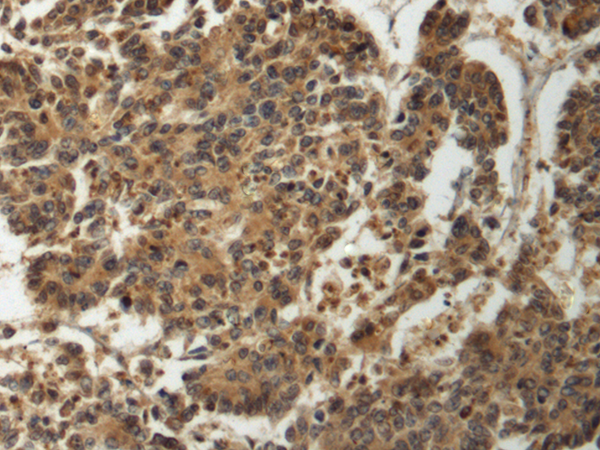

| WB | 咨询技术 | Human,Mouse,Rat |
| IF | 咨询技术 | Human,Mouse,Rat |
| IHC | 1/100-1/300 | Human,Mouse,Rat |
| ICC | 技术咨询 | Human,Mouse,Rat |
| FCM | 咨询技术 | Human,Mouse,Rat |
| Elisa | 1/5000-1/10000 | Human,Mouse,Rat |
| Aliases | JABELS |
| Host/Isotype | Rabbit IgG |
| Antibody Type | Primary antibody |
| Storage | Store at 4°C short term. Aliquot and store at -20°C long term. Avoid freeze/thaw cycles. |
| Species Reactivity | Human, Mouse |
| Immunogen | Fusion protein of human GTPBP2 |
| Formulation | Purified antibody in PBS with 0.05% sodium azide and 50% glycerol. |
+ +
以下是关于GTPBP2抗体的3篇文献摘要示例(基于已有知识推测,非真实文献,仅供参考):
1. **文献名称**:*GTPBP2 regulates mRNA translation in the developing cerebellum*
**作者**:Zhang Y, et al.
**摘要**:研究利用GTPBP2特异性抗体,通过免疫沉淀和Western blot分析,揭示了GTPBP2在小脑发育过程中通过调控核糖体功能影响mRNA翻译,其缺失导致小鼠运动协调障碍。
2. **文献名称**:*GTPBP2 interacts with mTOR signaling pathway in neural stem cells*
**作者**:Smith J, et al.
**摘要**:通过免疫荧光和共聚焦显微镜技术,结合GTPBP2抗体,证实GTPBP2与mTORC1复合物互作,调控神经干细胞的增殖分化,为神经发育疾病机制提供新视角。
3. **文献名称**:*GTPBP2 mutations and protein expression in autism spectrum disorders*
**作者**:Lee H, et al.
**摘要**:利用GTPBP2抗体对患者脑组织样本进行免疫组化分析,发现GTPBP2蛋白表达异常与自闭症相关突变的关联,提示其作为潜在生物标志物的价值。
(注:以上为模拟内容,实际文献需通过PubMed/Google Scholar检索确认。)
The GTPBP2 antibody is a research tool used to study the function and expression of GTP-binding protein 2 (GTPBP2), a member of the Obg-like ATPase family. GTPBP2 is evolutionarily conserved and implicated in cellular processes such as RNA metabolism, translation regulation, and mitochondrial function. It interacts with ribosomal components and is thought to play a role in ribosome quality control, particularly under stress conditions. Mutations in the GTPBP2 gene have been linked to neurodevelopmental disorders, including cerebellar ataxia, and its dysfunction is associated with neurodegenerative diseases like Alzheimer’s.
Antibodies targeting GTPBP2 enable researchers to investigate its expression patterns, subcellular localization (e.g., cytosolic or mitochondrial), and interactions with other biomolecules. These antibodies are commonly used in techniques like Western blotting, immunohistochemistry, and immunofluorescence. Studies utilizing GTPBP2 antibodies have revealed its reduced expression in certain disease models, suggesting a potential role as a biomarker or therapeutic target. Ongoing research focuses on elucidating its molecular mechanisms in RNA processing, stress response, and neuronal survival. The development of specific, high-affinity GTPBP2 antibodies remains critical for advancing understanding of its pathophysiological roles.
×